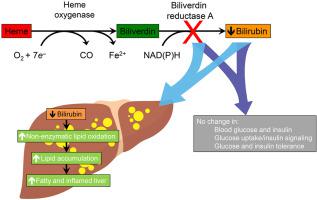Redox Biology ( IF 11.4 ) Pub Date : 2021-09-27 , DOI: 10.1016/j.redox.2021.102152 Weiyu Chen 1 , Sergey Tumanov 1 , Daniel J Fazakerley 2 , James Cantley 3 , David E James 4 , Louise L Dunn 5 , Taqi Shaik 6 , Cacang Suarna 1 , Roland Stocker 7

|
Background & aims
Plasma concentrations of bilirubin, a product of heme catabolism formed by biliverdin reductase A (BVRA), inversely associate with the risk of metabolic diseases including hepatic steatosis and diabetes mellitus in humans. Bilirubin has antioxidant and anti-inflammatory activities and may also regulate insulin signaling and peroxisome proliferator-activated receptor alpha (PPARα) activity. However, a causal link between bilirubin and metabolic diseases remains to be established. Here, we used the global Bvra gene knockout (Bvra–/–) mouse as a model of deficiency in bilirubin to assess its role in metabolic diseases.
Approach & results
We fed mice fat-rich diets to induce hepatic steatosis and insulin resistance. Bile pigments were measured by LC-MS/MS, and hepatic lipids by LC-MS/MS (non-targeted lipidomics), HPLC-UV and Oil-Red-O staining. Oxidative stress was evaluated measuring F2-isoprostanes by GC-MS. Glucose metabolism and insulin sensitivity were verified by glucose and insulin tolerance tests, ex vivo and in vivo glucose uptake, and Western blotting for insulin signaling. Compared with wild type littermates, Bvra–/– mice contained negligible bilirubin in plasma and liver, and they had comparable glucose metabolism and insulin sensitivity. However, Bvra–/– mice exhibited an inflamed and fatty liver phenotype, accompanied by hepatic accumulation of oxidized triacylglycerols and F2-isoprostanes, in association with depletion of α-tocopherol. α-Tocopherol supplementation reversed the hepatic phenotype and observed biochemical changes in Bvra–/– mice.
Conclusions
Our data suggests that BVRA deficiency renders mice susceptible to oxidative stress-induced hepatic steatosis in the absence of insulin resistance.
中文翻译:

胆红素缺乏使小鼠在没有胰岛素抵抗的情况下易患肝脂肪变性
背景与目标
血浆浓度胆红素,胆绿素通过还原酶A(BVRA),逆关联与代谢性疾病,包括肝脂肪变性和糖尿病的风险形成血红素分解代谢的产物糖尿病是人类的。胆红素具有抗氧化和抗炎活性,还可以调节胰岛素信号传导和过氧化物酶体增殖物激活受体 α (PPARα) 活性。然而,胆红素与代谢疾病之间的因果关系仍有待确定。在这里,我们使用全局Bvra基因敲除 ( Bvra –/– ) 小鼠作为胆红素缺乏症模型来评估其在代谢疾病中的作用。
方法与结果
我们给小鼠喂食富含脂肪的饮食以诱导肝脏脂肪变性和胰岛素抵抗。通过 LC-MS/MS 测量胆汁色素,通过 LC-MS/MS(非靶向脂质组学)、HPLC-UV 和油红-O 染色测量肝脂质。通过GC-MS测量F 2 -异前列腺素来评价氧化应激。葡萄糖代谢和胰岛素敏感性通过葡萄糖和胰岛素耐受性测试、离体和体内葡萄糖摄取以及胰岛素信号传导的蛋白质印迹得到证实。与野生型同窝仔鼠相比,Bvra –/–小鼠血浆和肝脏中的胆红素可忽略不计,而且它们的葡萄糖代谢和胰岛素敏感性相当。然而,Bvra –/–小鼠表现出炎症和脂肪肝表型,伴随着氧化三酰甘油和 F 2 -异前列腺素的肝脏积累,与α-生育酚的消耗有关。α-生育酚补充剂逆转了Bvra –/–小鼠的肝脏表型并观察到了生化变化。
结论
我们的数据表明,在没有胰岛素抵抗的情况下,BVRA 缺乏使小鼠容易受到氧化应激诱导的肝脂肪变性的影响。


























 京公网安备 11010802027423号
京公网安备 11010802027423号